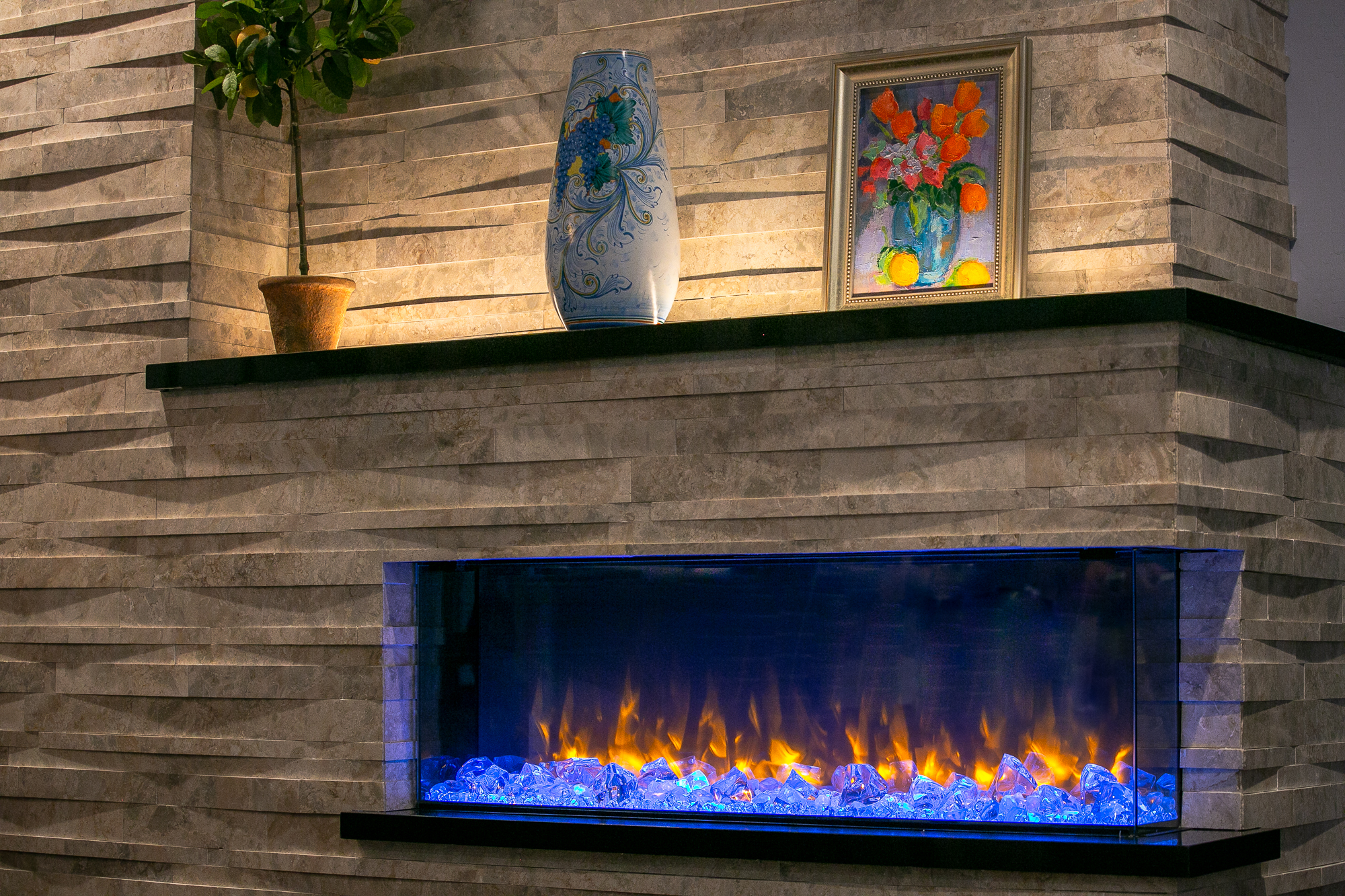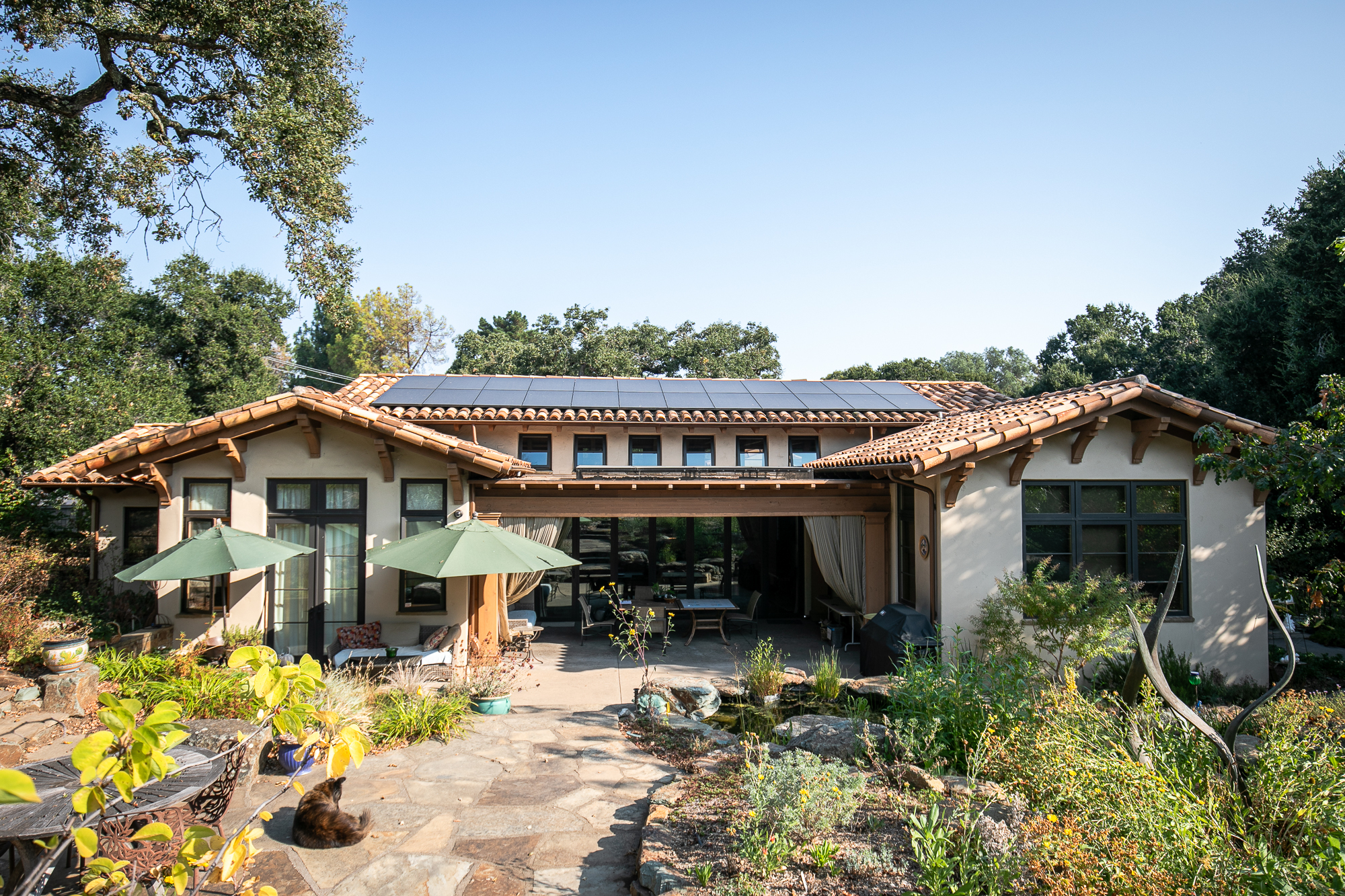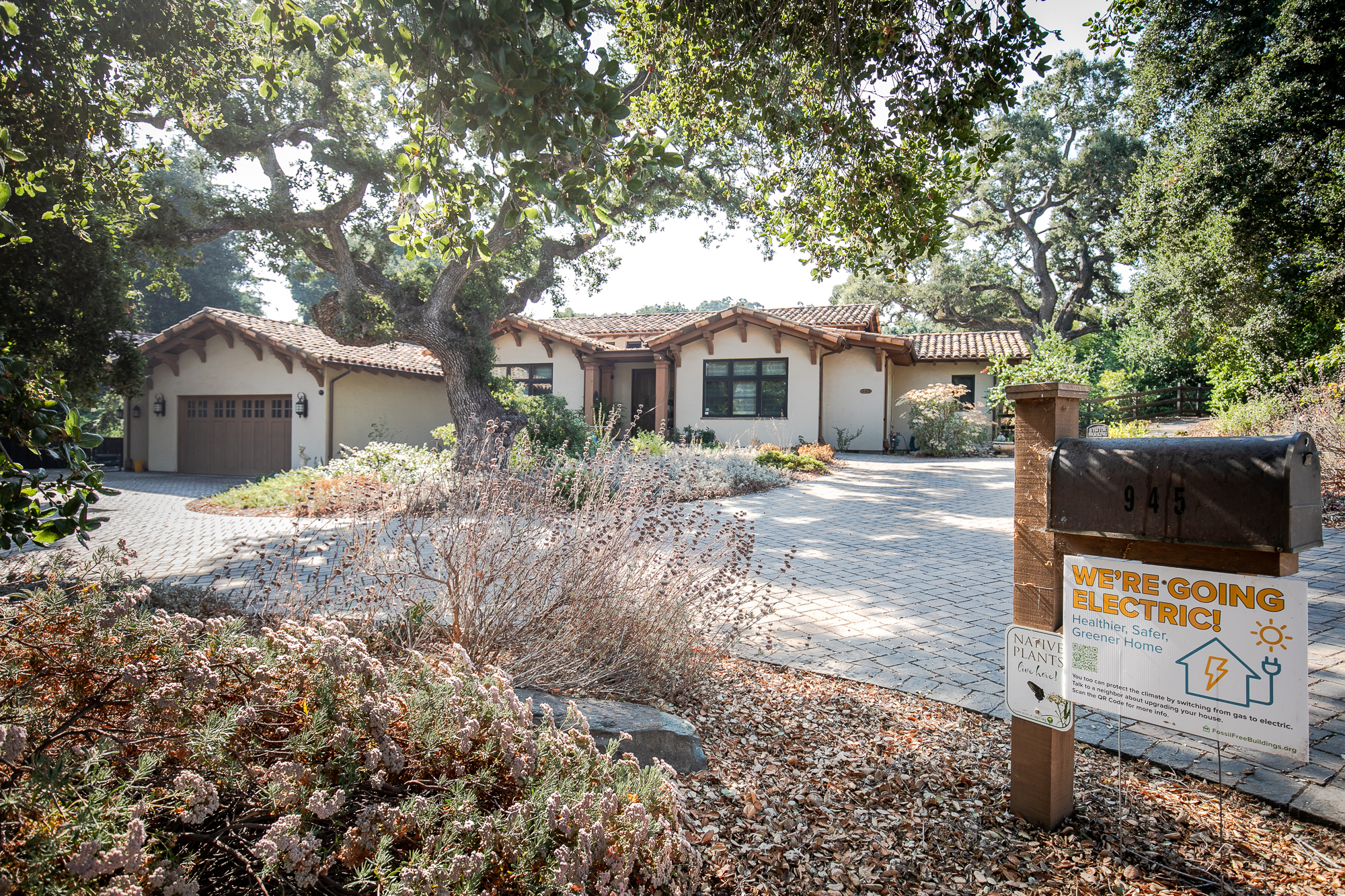Four years ago, Jeff and Debbie Byron decided it was time to ditch their gas appliances and electrify their 1962-era rancher in Los Altos. They planned the conversion in stages, starting with the installation of a heat-pump water heater, followed by an electric air exchanger to heat and cool the house.
Today, the entire 2,800-square-foot home is all electric. In the kitchen, there's an induction cooktop and an energy-efficient refrigerator. In the laundry room is an all-electric dryer, which enabled the couple to completely cut off the gas line to their home.
The garage boasts a Level 2 EV charger that can quickly charge their car. Their latest addition is an electric fireplace with lively colors, which has become a visual centerpiece for their living room.
"I kind of like to be able to say we don't burn any carbon to heat up our home. It's fossil-free," said Jeff Byron, who served on the California Energy Commission from 2006 to 2011. "But the real benefit that I think would appeal to everyone is that it's cheaper ... than having natural gas."
The couple's all-electric home, which has been named a Silicon Valley Clean Energy Award winner, is among the 40-plus homes in Santa Clara and San Mateo counties that will be showcased in this year's Electric Home Tour on Saturday, Oct. 14.
Sponsored by Silicon Valley Clean Energy, Peninsula Clean Energy and the city of Palo Alto, the annual tour provides the public an opportunity to explore a variety of homes that have been either retrofitted, remodeled or newly built with electric conversion features, and gain insights about the process and the appliances firsthand from the homeowners themselves.
From midcentury ranchers and Eichlers to duplexes, townhomes and apartments, this year's tour provides diverse examples of electrified, climate-friendly living. Homes on the tour range from those that have at least two electric conversion features to those that are all-electric to ones that are net-zero and produce as much energy on an annual basis as they consume.
The transition to all-electric
The Byrons' home is among those on the tour that have completely ditched their gas lines. The duo said they were both eager to shrink their carbon footprint. The process to all-electrification, however, didn't come without concerns or challenges, Jeff said.
For Debbie, she was hesitant about giving up her gas stove when the time came to upgrade the kitchen, she told Silicon Valley Clean Energy when she and her husband received their clean energy award.
"I had cooked on it for a long time," she said. "I have a friend who said she had worked with an induction stove and liked it, so we went shopping, tried it out. And as it turns out, it's really marvelous."
Jeff said a big challenge they encountered when first starting the process was finding contractors familiar with cutting-edge electric appliances who could do the work.
"There were very few contractors who actually knew what to do and how to properly install (some of the appliances)," he said.
That's changing as more homeowners move away from natural gas to heat their homes and operate their appliances, he said.
"There are now more manufacturers, more supplies, more competition and more options for consumers to choose from," Jeff said.
In 2022, electric heat pump sales exceeded gas water heater sales for the first time in the U.S., according to the International Energy Agency. Financial incentives, according to the agency, have helped drive sales. The price for the cheapest heat pump models are now comparable to that of a new gas water heater.
Depending on the brand and size, a heat pump water heater can cost between $1,500 and $3,000, not including installation costs or state rebates. Gas water heaters can start as low as $700 and go all the way up to $2,700, according to data from LiveFree.
Building from scratch
Like the Byrons, Peter and Melanie Cross' home also is all-electric. The Palo Alto couple embarked on their electrification process 12 years ago by selecting a plot of land with mature trees and plenty of sun for their solar panels.
Unlike the Byrons, who updated their 1960s home, the Cross' designed and built their home from scratch with energy efficiency in mind during every step of the process to create a climate-friendly, net-zero residence.
They incorporated design elements, such as a row of windows close to the roofline for additional light, and created a longer overhang to shade them.
Their home includes solar panels on the roof, an electric heat pump for their water and HVAC systems, an induction cooktop and a Level 2 EV charger for their car.
Their latest upgrade is a Tesla Powerwall lithium battery backup system. During last winter's big storms, when wind and fallen trees caused local power outages, their lithium battery kicked in and they were never without electricity, the couple said.
What they learned along the way
The Cross' said they understand that not everyone has the luxury of creating a net-zero, all-electric home from scratch. There are plenty of other ways to make your existing home more energy efficient, they said.
"(Installing) a heat pump is a good start. Don’t wait until your hot water heater breaks to change it out," Peter said. "Get the electric service in first, and be ready when the old water heater breaks. It will be a quick change."
Despite all of their painstaking planning, Peter said there is one thing they would have done differently.
"If we had to do it over again or upgrade, we would have several, small tankless heaters located near fixtures throughout the house,” he said. "The hot water would be instant with the tankless, and there wouldn't be the need for a pump to constantly circulate the hot water throughout the house."
For those looking to convert to electric, Jeff Byron recommended becoming familiar with clean energy options available through the state's Community Choice Aggregation (CCA) program. Through the program, cities and counties can buy or generate clean energy for residents and businesses within their communities as an alternative to gas and electricity provided by PG&E. Peninsula Clean Energy is the alternative provider in San Mateo County, and in Santa Clara County, it's Silicon Valley Clean Energy. Through their websites, residents can find different service plans, rebates, information on how to obtain 0% loans for electric conversion projects and tips on how to go all-electric, as well as how to find a contractor.
How to tour the homes
This year's tour includes homes in Brisbane, Burlingame, Cupertino, Foster City, Hillsborough, Los Altos, Menlo Park, Millbrae, Montara, Morgan Hill, Mountain View, Pacifica, Palo Alto, Redwood City, San Carlos, San Jose, San Mateo, Santa Clara, South San Francisco and Sunnyvale.
The Electric Home Tour is free, but participants must register by Thursday, Oct. 12, to receive the list of homes featured on the tour.
Homes will be open to tour from 10 a.m. to 4 p.m. on Saturday, Oct. 14.







Comments
Registered user
Menlo Park: Allied Arts/Stanford Park
on Oct 1, 2023 at 2:13 pm
Registered user
on Oct 1, 2023 at 2:13 pm
It is awesome to see that more and more homes are converted away from fossil fuels.
The rebates and the IRA help make it more affordable now, though it is by no means free.
However, one should not think of electrification as an expense. It is an investment in a cleaner, more efficient and healthier future. And one day, when the house is sold, it may well fetch a higher price than if it had been left behind in the gassy past.
Registered user
Menlo Park: Allied Arts/Stanford Park
on Oct 2, 2023 at 3:49 pm
Registered user
on Oct 2, 2023 at 3:49 pm
Do these people not know or do they not want to admit the majority of the electricity generated to their homes comes from fossil fuels? You are charging your EV with natural gas.
Sorry guys no free lunch.
Registered user
Menlo Park: other
on Oct 2, 2023 at 3:51 pm
Registered user
on Oct 2, 2023 at 3:51 pm
Thank you Westbrook, you beat me to it. Electrification without a non-fossil fuel source of electricity is just trading the location at which the CO2 is generated. And it is less efficient than if you simply burned the gas where you are when you factor in the losses sustained in generation, transmission and in some cases battery charging. It's either naivete or virtue signalling.
Registered user
another community
on Oct 2, 2023 at 8:31 pm
Registered user
on Oct 2, 2023 at 8:31 pm
Westbrook, your electricity comes from Peninsula Clean Energy. It is 100% clean on a yearly basis. It will be 100% clean on a 24//7/365 basis by 2027. No fossil fuel. Peninsula Clean Energy continues to purchase more wind, solar, and battery power that will replace all fossil fuel, even the small amounts distributed now.
Registered user
another community
on Oct 2, 2023 at 10:18 pm
Registered user
on Oct 2, 2023 at 10:18 pm
Westbrook and Menlo Voter, if you aren’t already, switch to PCE for your electricity. It is the default for all residents in San Mateo County. Their ECO100 plan procures 100% of the energy from renewable sources. Default plan has very low c02 emissions. See Web Link for more details
Electricity is being and can continue to be procured from clean resources. Gas will always be burning fossil fuel and carbon intensive.
Registered user
Menlo Park: Allied Arts/Stanford Park
on Oct 3, 2023 at 4:36 pm
Registered user
on Oct 3, 2023 at 4:36 pm
Contrary to what the previous posts want you to believe, data tells us that using a heat pump water heater reduces GHG emissions by 80% over a gas water heater. The intuition is simple:
1. Most of our electricity is now from clean sources that don’t emit CO2. Gas water heaters obviously are CO2-generating machines, and methane leaks further increase their emissions.
2. Gas water heaters are up to 80-90% efficient in turning gas into heat, but heat pumps are 350-400% efficient, because they move heat from the air, rather than generating it.
Not only do heat pump water heaters reduce emissions by 5x, they keep NOx, benzene and formaldehyde and other harmful gasses out of our homes.
And they are not expensive: they can be obtained for about the same cost as gas water heater after all rebates and tax credits are applied.
In closing I would like to point you to this web site which, though specific to San Mateo County, does a fabulous job of describing the advantages of heat pump water heaters:
Web Link
Registered user
Menlo Park: Allied Arts/Stanford Park
on Oct 3, 2023 at 4:39 pm
Registered user
on Oct 3, 2023 at 4:39 pm
Here are detailed calculations to back up the conclusions in the previous post: that a heat pump water heater emits 80% less greenhouse gasses than a methane water heater. I also provide references for the most important data.
----- you are welcome to skip the rest -----
We calculate the gas combustion emissions that result from putting one joule of energy into the water.
First the gas water heater.
Noncondensing models (most common by far) are up to 90% efficient. Generally, 5% of the gas produced at the well head leaks before it reaches the final consumption point but let's ignore this for simplicity. So to get 1 joule into the water, we combust 1 / 0.9 = 1.1 joules of gas.
Now the heat pump water heater.
Per this CEC's report, in California in 2022 Web Link 54.2% of total electricity production was emissions-free and 45.8% was gas combustion in a variaty of plants with different efficiencies (peaker plants, combined cycle gas turbines, old plants, new plants). For simplicity, we can (generously) use a 50% efficiency number for California's gas fleet: Web Link
Per Rheem/Ruud, their heat pump water heaters have a Uniform Energy Factor (UEF) of 4.0; link: Web Link
To put 1 joule of heat into the water, we need 0.25 joules of electricity at the water heater. (Just like we ignored gas leaks, let's ignore electricity transmission and distribution loss for simplicity.) Of these 0.25 joules of electricity, 0.25 * 45.8% = 0.11 joules are produced by gas combustion. At 50% fleet efficiency, this means combusting 0.22 joules of gas.
So the gas water heater will actually pollute 1.1 / 0.22 = 5x more than using an electrical heat pump.
Registered user
Menlo Park: other
on Oct 3, 2023 at 7:36 pm
Registered user
on Oct 3, 2023 at 7:36 pm
San Mateo County Resident:
PCE is just "greenwashed" power. The power coming from the grid is a blend of all types of power. Until the power coming to my home is coming directly from renewable sources only, it is all the same power and a large portion of it is produced by burning natural gas.
Registered user
Menlo Park: Suburban Park/Lorelei Manor/Flood Park Triangle
on Oct 4, 2023 at 5:50 pm
Registered user
on Oct 4, 2023 at 5:50 pm
People like Menlo Voter will not be convinced by facts.
Folks like that are content to sit and do nothing, or even convince others to do nothing, while the world burns.
The data is clear. Switching to all electric dramatically reduces carbon emissions. We should all be moving in that direction, each at our own fastest possible pace.
Registered user
Menlo Park: other
on Oct 4, 2023 at 6:52 pm
Registered user
on Oct 4, 2023 at 6:52 pm
Ronen:
The data is clear that if you switch to all electric and have a non-fossil fuel derived electricity reduces carbon emissions.
Registered user
Menlo Park: Allied Arts/Stanford Park
on Oct 4, 2023 at 7:53 pm
Registered user
on Oct 4, 2023 at 7:53 pm
Anecdotally,
"Additionally, to help pay for the infrastructure required to meet Panasonic’s anticipated electricity demand, Evergy plans to ask the Kansas Corporation Commission (KCC) for a rate increase on residential customers’ energy bills in parts of the state, according to The Kansas City Star."
Also, They are currently deriving partial power from burning coal.
My question to you is 100% renewables at what cost? $
Kansas residents weren't told of future rate increases.